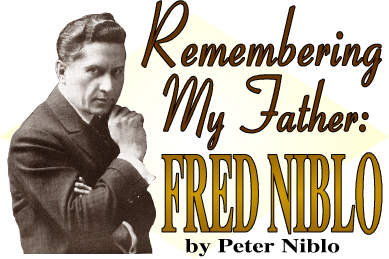

My Dad was born in York, Nebraska, in 1874. His name at that time was Fred Liedtke, the son of Frederick Liedtke, born in 1836 in Prussia, and his mother was Annette Dubergere Liedtke, born in France in 1845. His father and mother were divorced in 1881.
In his early years, after his parents separated, Dad and his mother went to New York City. He started working at a theater and coffee house named Niblo Gardens located at Broadway and Prince Streets. The business was created by a man of Irish descent named William Niblo. It is believed that my Dad started his Broadway acting career there. He adopted the Niblo name to pursue his career.
"His first adventure was a financial venture with George M. Cohan, when the latter became an independent producer. Mr. Niblo then took a rover's chance in musical comedy, dramatic productions or comedies, whichever happened along. He wrote and starred in a number of successful stage plays. He will be remembered in such lively productions as 'Hit-the-Trail-Holliday' and 'The Fortune Hunter.'" (The Blue Book of the Screen, The Blue Book of the Screen, Inc., 1923)
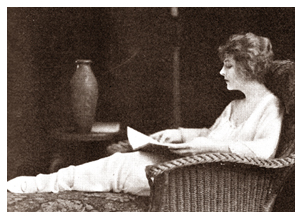 He became a successful
Broadway actor, and was closely associated with George M. Cohan
and the family. In July, 1901, Dad married George's sister, Josephine
Cohan, and the two traveled worldwide. They took trips to Africa
during the years before World War I.
He became a successful
Broadway actor, and was closely associated with George M. Cohan
and the family. In July, 1901, Dad married George's sister, Josephine
Cohan, and the two traveled worldwide. They took trips to Africa
during the years before World War I.
"In 1907, Mr. Niblo carried the first moving picture camera through and across central Africa . . . As far as anyone knows, he filmed the only moving pictures ever taken within the walls of the sacred Kremlin n Moscow, Russia. Mr. Niblo's last starring engagement on Broadway was in 'Hit-the-Trail-Holiday' written for him by George M. Cohan." (The First One Hundred Men and Women of the Screen by Carolyn Lowrey, Moffat Yard and Col, 1920). (Photo at left: Mrs. Fred Niblo (Enid Bennett) relaxing at home in the late 1920's.)
They had one son, Fred Jr. He was involved in Hollywood as a screenwriter with quite a few movies to his credit between 1930 and 1950. Fred and I were friends. We both worked on jobs in Vietnam during the war and saw a lot of each other. Fred and his wife, Patricia, have long gone.
In 1916, after 15 years of marriage, Josephine Cohan Niblo died. The following year, Dad went to Australia where he met my mother, Enid Bennett, who was born in Australia in 1893. They were married in 1918 and returned to America to become leading players in the new Hollywood.
Dad's first opportunity to direct was "The
Marriage Ring" (1918) starring Enid Bennett. As time went
on, he directed many of the top films and stars of the silent
era including "The Mark of Zorro" (1920) and "The
Three Musketeers" (1921) with Douglas Fairbanks, "Blood
and Sand" (1922) with Rudolph Valentino, "The Red Lily"
(1924) with my Mom and Ramon Novarro (which Dad also wrote), "Camille"
(1927) with Norma Talmadge, and two Greta Garbo films, "The
Temptress" (1926) and "The Mysterious Lady" (1928).
The film for which he is best remembered is the 1926 production
of "Ben Hur" for MGM, much of which was filmed in Italy.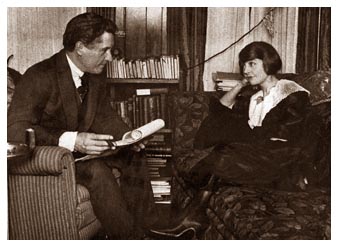
"The grand opening of 'Ben Hur' at the George M. Cohan Theater in New York last month was a gala event. . . Fred Niblo was rushed at the finish of he picture and it looked as if he would never get out of the theater. A hundred friends wanted to congratulate him. He apologized for the dampness of his palm, which was only caused by the nervousness he felt waiting for the picture's reception." (Photoplay magazine, March 1926). (Photo at right: Mr. and Mrs. Fred Niblo (Enid Bennett) from a July 1920 magazine article)
I was born in March of 1925, just after Mother and Dad returned from Italy for the filming of "Ben Hur." Mother once told me that I was "conceived in Italy" -- why she told me that I'll never know.
He and my mother, my two sisters and I lived in a home designed and created by him in Beverly Hills (now owned and occupied by the Rupert Murdoch family). My older sister, Loris, and I were never close. She passed away very early. Judy, the youngest of us all, married a Naval Academy graduate and U.S. Naval officer in 1952 who is now retired. They live in Northern California. Judy attended grammar school with a young lady named Shirley Temple.
None of Dad and Mother's children tried to enter the entertainment industry. The closest I got to entertainment was getting a book published. The non-fiction book is an espionage history of the penetration of the Roosevelt administration by our ally, "Uncle Joe" Stalin. It is titled Influence, The Soviet 'Task' Leading to Pearl Harbor, The Iron Curtain and the Cold War.
At home, Dad was strict. Unlike today, fathers
in those days were in charge. Mother was a wonderful lady who
led me step by step. But when I got carried away, one look from
my Dad ended it all. His German ancestry came through. He was
tough, but very much on the right track. He loved classical music
and gave me a look when I cranked up the phonograph to play Dixieland.
In our home in Beverly Hills, my parents had a movie theater.
Friends, most from the movie industry, came often to see something.
There were photos of the movie stars of the Roaring Twenties all
over the place, but I can't recall whom among them I may have
met, although I'm sure quite a few. I don't remember Mother or
Dad discussing movies with me, but I do remember hearing them
both discuss all sorts of subjects  including
directors, producers, actors and stories.
including
directors, producers, actors and stories.
"I know two Fred Niblos. One is the
director on the set, with a fortune at stake and the responsibility
for a great production on his shoulders. The other is the fireside
Fred Niblo, with weary hours behind him, and none of the barriers
and customs that aid in keeping a man courteous through the day.
The two match up remarkably well. Keeping a director waiting on
the set and keeping a husband waiting for breakfast are two unforgivable
offences. But I have kept Director Niblo waiting and I've kept
Husband Niblo waiting, and I've never been able to annoy him out
of his inherent kindness and courtesy. He is the kindest man I
ever knew. His heart is filled with charity and a splendid appreciation
of the fine things in life. He is an ideal husband and an ideal
director." (Enid Bennett in Photoplay
magazine, September 1923) (Photo at left: Mayfair Club
Ball 1927: Mrs. Louis B. Mayer, Fred Niblo, Mrs. Conrad Nagel,
Louis B. Mayer, Mrs. Fred Niblo (Enid Bennett) and Conrad Nagel.)
I do not remember that I was ever at the MGM studio at a time
my father was actually directing. I do remember being shown around
the studio by him, introducing me to people, and in one case being
photographed with him and his friends at MGM.
The stars and directors that I do remember meeting on one or more
occasions include Katharine Hepburn, Nelson Eddy, Conrad Nagel,
C. Gardiner Sullivan, Sidney Franklin, Mary Pickford and Douglas
Fairbanks.
"Fred Niblo directed ('The Three Musketeers' starring Douglas Fairbanks - 1921), and in more than one way he has accomplished a film that can stand by itself imaginatively and pictorially. By the movement of the scheming Richelieu's hand he characterizes him, by the substitution of action for words he gives incidents and events a graphic significance, and in more than several instances gets scenic effects that both startle and satisfy." (The New York Evening Post, August 29, 1921)
Conrad Nagel took me on my first surfboard
ride one day at the beach in Malibu. Mary Pickford and Douglas
Fairbanks gave me a silver cup for my christening, their names
engraved, a present I still have today. On one or two Christmas
occasions I delivered our family presents to Nelson Eddy who lived
nearby. One day Nelson gave me one of his pipes, a gift I still
have today. Ann and Gardiner Sullivan gave me a piece of furniture
that we still have and use today.
The famous director Sidney Franklin was our friend for a long
time. My wife, Sylvia, and I stayed several times at his mansion
in Malibu.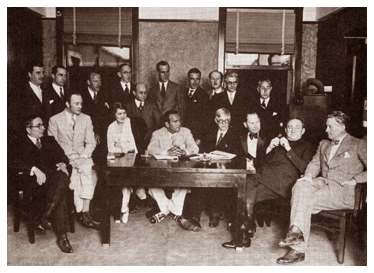
I don't remember that my father discussed movie personalities
with me, but for some reason when I mentioned one day that I had
watched a scary Boris Karloff film named "Frankenstein,"
he said that he had interviewed Mr. Karloff when Karloff was just
entering the business, and that he was a very handsome guy.
My father was one of the founders of the Academy of Motion Picture Arts and Sciences along with Conrad Nagel and Louis B. Mayer. The first officers of the AMPAS were Douglas Fairbanks, president; Fred Niblo, vice-president; M.C. Levee, treasurer; and Frank Woods, secretary. (Photo at right: The founding of the Academy of Motion Picture Arts and Sciences. Seated: Louis B. Mayer, Conrad Nagel, Mary Pickford, Douglas Fairbanks, Frank Woods, M. C. Levee, Joseph M. Schenck and Fred Niblo. Standing: Cedric Gibbons, J.A. Ball, Carey Wilson, George Cohen, Edwin Loeb, Fred Beetson, Frank Lloyd, Roy Pomeroy, John Stahl and Harry Rapf.)
"Details of the workings of the organization were not in shape for release last night. It was stated, however, the new body will cooperate with existing bodies, such as the Motion Picture Producers' Association, in movements beneficial to the industry and will in addition, encourage by prizes, scholarships and other means, any move for the improvement of the industry as a whole." (The Los Angeles Times, May 5, 1927)
He was also one of the founders of the City of Beverly Hills, and there is a statue of the founders located at Beverly Drive and Olympic Blvd.
As for me, I joined the Marine Corps in 1943 when I was 17 years old. I was one of the troops at Tarawa, Saipan, Tinian, Okinawa, Ie Shima and was one of the first Marines to enter Nagasaki in the middle of he night a few months after the bomb dropped. After the war, I tried college but had no interest in sitting there. I was a radio operator, so I went to work for a new cargo airline named Flying Tigers that made trips from Los Angeles to Tokyo.
After that, I went to work as a radio operator on a Standard Oil tanker in Alaska, and later I was hired by the Los Angeles Police Department communications unit, ultimately getting transferred to the Crime Lab. During those years I stayed in the Marine Corps reserve and saw duty every summer.
One day I received a call from the brand new CIA and was hired. After reporting to CIA in Washington, my Marine Corps unit was assigned to Korea, so I left the CIA and went back to Camp Pendleton where I was eventually assigned to a ship. But the war ended, and I was able to return to my CIA job where I was employed there from 1951 to 1956. Then I joined Federal Law Enforcement from which I retired in 1980.
While an agent of the Old Federal Bureau of
Narcotics in San Francisco, I was introduced to a charming lady.
We were married in 1964, and she and I, and her three sons from
a previous, lived in Hong Kong where I had been assigned to open
the FBN office. Our oldest son went to the Naval Academy and then
joined the Marine Corps. He advanced to Lt. Colonel (I had been
a sergeant) but sadly passed away a few years ago from cancer.
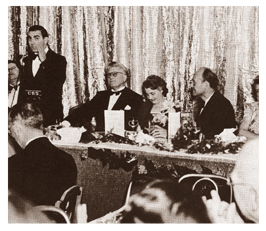 Number two son is Executive Vice
President of the Central Pacific Bank in Hawaii. Our youngest
son, a physician, is a captain in the U.S. Navy, and now commands
a Navy hospital near Seattle.
Number two son is Executive Vice
President of the Central Pacific Bank in Hawaii. Our youngest
son, a physician, is a captain in the U.S. Navy, and now commands
a Navy hospital near Seattle.
My father died back in 1948 while on a trip with my mother to New Orleans. My mother sold our Brentwood home after Dad passed and moved into a small home in West Hollywood. Within these years, Sidney Franklin's wife passed away, and mother and Sidney continued a long friendship, and were ultimately married and lived in the Malibu mansion. (Photo at left: The Silver Anniversary of Beverly Hills in 1939: Eddie Cantor, Mr. and Mrs. Fred Niblo, and Conrad Nagel.)
For those who may not know, Sidney began directing in 1915 and had several famous silent and sound films to his credit such as "Heart O' the Hills" (1919) and "The Hoodlum" (1919) with Mary Pickford, "Smilin' Through" (1922) with Norma Talmadge, "Her Sister From Paris" (1925) and "The Duchess of Buffalo" (1926) with Constance Talmadge, "Wild Orchids" (1929) with Greta Garbo, "The Barretts of Wimpole Street" (1934) with Norma Shearer, and "The Good Earth" (1937) for which he was nominated for Best Director.
Mother passed away in 1969 and Sidney three years later.
Looking back over the years, I will never forget one evening my father took me out to the front of the house and pointed east. He said, "Do you see that glow way, way over there? That is Los Angeles." Times have changed.
I was and continue to be a very fortunate offspring of two of Hollywood's best, my mother and father.
"Fred Niblo was a model of the conscientious, craftsman-like, entirely professional director of the twenties." (Hollywood in the Twenties by David Robinson, Tantivy Press, 1968).